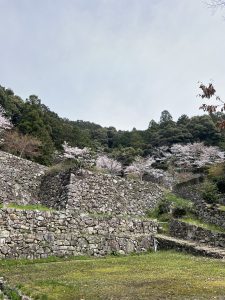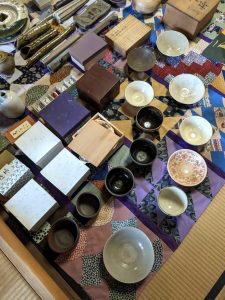みなさまこんにちは、スタッフYでございます。

このところの密かな趣味として「城跡巡り」をしているのですが、桜の季節に合わせていい所はないか…と、思っておりましたら、ちょうど戦国時代の織田信長と共に必ず登場するのが「安土桃山城」が、めちゃくちゃ気になってきまして、今はどんな様子なのか?桜と共にいい写真が撮れるのではないかの期待も込めてちょっと行って参りました。
安土桃山城、滋賀県のJR安土駅の北東に位置しまして、、標高198mの安土山一帯にある織田信長(1534-82)の居城跡なのですが、やはり国指定の特別史跡であります。現在は観光用に駐車場なども整備されており、アクセスは悪くない。
天正4年(1576年)から織田信長がなんと約3年の歳月をかけて完成、安土・桃山時代の幕開けとして築城されましたが、織田信長が倒れた本能寺の変後、焼失して築城6年で消え去ります。そして現在、石垣だけが残っております。
安土山の南側には、堀が巡っていて往時の名残りを留めています。天主跡と本丸跡には礎石があったり、また二の丸跡には、豊臣秀吉が建立した織田信長廟も残っております。

天主閣跡から東へ少し下った黒金門跡(くろがねもんあと)付近には、壮大な石垣もあります。また、山の中腹には豊臣秀吉や前田家などの家臣団屋敷跡がありました。お城のすぐそばに居を構えていたようで、その痕跡の石垣だけが残るのみですが、ちょうど桜がその寂しさをうめてくれているようでありました。

山の尾根づたいに北へ行くと八角平や薬師平があるのですが、石段が思いのほかきついことに気づき始め少し後悔が襲ってきました。が、ここまできますと、城山の中心部への通路は、南正面から入る大手道のほかに、東門道、百々橋口道、搦手道などがあり、ここまで来たのに引き返してはならぬ気がして、笑う膝と闘いながら石段を登り続けます。そしてようやっと天守閣跡が見えてきます。

ところで実際の安土桃山城の外面は、各層が朱色・青色・あるいは白色、そして最上層は金色だったといいます。内部は、狩野永徳が描いた墨絵で飾られた部屋や、金碧極彩色で仕上げた部屋などがあり、南蛮史料には「壁は頂上の階の金色と青色を 塗りたる」という記述があるそうです。
当時の日本最高の技術と芸術の粋を集大成して造られたといわれており、わが国最初の本格的な天主の建築はこの安土城が始まりとされております。


ですが歴史上に名を残す名城跡、天守閣から見える景色はご覧の通り、肥沃な田んぼと琵琶湖を見下ろす長閑な立地でありまして。当時の城下町はもう少し栄えていたとは思うのですが、現在の大都会のような風景ではないとは思いますし、いきなりな見たこともないド派手天守閣に、周りの住民は度肝を抜かされたのではないでしょうか。
ここにお城を構えたのは、戦いや物資の輸送などの利便的な理由もあったかともいますが、何処までも続く肥沃な田んぼや満々とに水をたたえた琵琶湖に、まずもって天下統一を成し遂げた満足感が湧いてきますし、納得の景色でありました。
それにしてもかなりきつい石段でありました。「天下布武」と唱えながら天下をとった織田信長の気持ちとなって琵琶湖を見下ろしたかったのですが、石段に注意しながら登ることが精いっぱいで、天下をとった気持ちなんてすっかり忘れておりまして…。
健脚に自信のおありのみなさま、忘れずに琵琶湖を眺めながら織田信長になりきって天下とってきてください。「天下布武」と、唱えながら。
それではごきげんよう。

Hello everyone, this is Staff Y.
I have been secretly enjoying “visiting castle ruins” as a hobby recently, and I was wondering if there is a good place to visit in time for the cherry blossom season… and I became very curious about “Azuchi-Momoyama Castle,” which always appears with Nobunaga Oda in the Sengoku period (1467-1568). What is it like now? I went there in the hope of taking some good pictures with the cherry blossoms.
Azuchi-Momoyama Castle, located northeast of JR Azuchi Station in Shiga Prefecture, is the site of the castle of Oda Nobunaga (1534-82) on the 198-meter-high Azuchi Mountain, and is a nationally designated special historic site. Currently, a parking lot and other facilities are available for sightseeing, and accessibility is not bad.
It took Oda Nobunaga a whopping 3 years from Tensho 4 (1576) to complete the castle, which was built as the beginning of the Azuchi-Momoyama period, but after the Honnoji Incident in which Oda Nobunaga fell, the castle was destroyed by fire and disappeared within 6 years of construction. Today, only the stone walls remain.
On the south side of Mt. Azuchi, a moat runs around the castle, retaining the vestiges of the old days. There are foundation stones at the ruins of the castle and the Honmaru, and the mausoleum of Oda Nobunaga, built by Toyotomi Hideyoshi, remains at the Ninomaru ruins.
There is also a magnificent stone wall near Kuroganemon-ato, a short distance down east from the Tenshukaku ruins. Also, on the hillside were the remains of the residences of vassals such as Toyotomi Hideyoshi and the Maeda family. It seems that they had settled close to the castle, and only a stone wall remains, but the cherry blossoms seemed to fill the loneliness.
Following the mountain ridge to the north, we reached Hakkakudaira and Yakushidaira, but I began to feel a little regret when I realized that the stone steps were unexpectedly steep. However, once I reached this point, I felt that I should not turn back after having come this far, and continued to climb the stone steps while fighting my laughing knees. Finally, the ruins of the castle tower come into view.
The actual exterior of Azuchi-Momoyama Castle is said to have been built with each layer in vermilion, blue, or white, and the top layer in gold. Inside, there are rooms decorated with ink paintings by Eitoku Kano and rooms finished in gold and blue, and a Nanban document describes that “the walls were painted gold and blue on the top floor.
It is said to have been built with the best of Japanese technology and art of the time, and it is believed that Azuchi Castle was the first full-scale construction of a castle tower in Japan.
As you can see, the view from the castle tower overlooks fertile rice fields and Lake Biwa. The castle town at that time may have been a bit more prosperous, but it was not like today’s big cities, and the residents must have been taken aback by the sudden appearance of the flashy castle tower, which they had never seen before.
The castle may have been built here for convenience in battles and transportation of goods, but the endless fertile rice paddies and Lake Biwa, filled with water, gave us a sense of satisfaction at having achieved unification of the country.
The stone steps were quite steep. I wanted to look down on Lake Biwa as if I were Oda Nobunaga, who chanted “Tenka-bufumu” and won the country, but I was so busy climbing the stone steps that I forgot how it felt to have won the country….
For those of you who are confident in your physical fitness, please do not forget to pretend to be Nobunaga Oda while gazing at Lake Biwa. I hope you will all go and take over the country, chanting “Tenka Fubu” as you do so.
Have a good day.
*******************
ご実家の整理やお片付けなどをされている方のご相談などが多くございます。
お片付けなどくれぐれもご無理のないようになさってくださいませ。
風光舎では古美術品や骨董品の他にも絵画や宝石、趣味のお品など様々なジャンルのものを買受しております。
お片付けをされていて、こういうものでもいいのかしらと迷われているものでも、どうぞお気軽にご相談下さいませ。
また風光舎は、出張買取も強化しております。ご近所はもちろん、愛知県内、岐阜県、三重県その他の県へも出張いたします。
まずは、お電話お待ちしております。
愛知県名古屋市千種区姫池通
骨董 買取【古美術 風光舎 名古屋店】
TEL052(734)8444
10:00-18:00 OPEN























